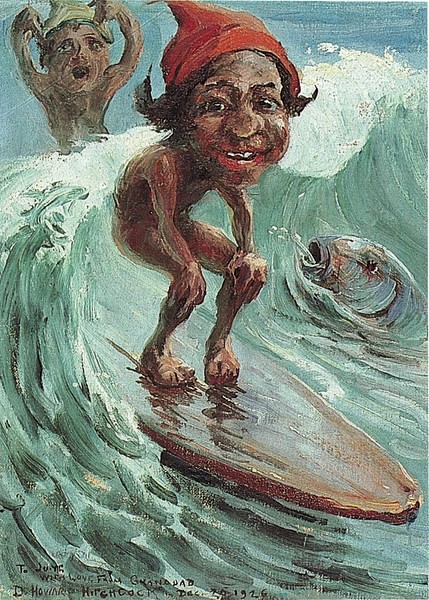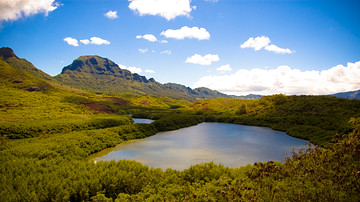
Menehune is the term applied to short-statured, forest-dwelling creatures of Hawaiian mythology and is part of a common mythology throughout Polynesia that describes secretive, supernatural beings with human-like attributes. Mysterious supernatural beings appear in the myths and legends of other Oceania cultures, such as the rock crevice-dwelling Mimis of Arnhem Land, Australia, who are thought to have taught indigenous Australians how to hunt, or the Kakamora of Melanesia, elf-like creatures that live in caves and love to dance but fear the colour white.
The Menehune, who stood around three feet (90 cm) tall, were thought to be skilled stonemasons who ventured out after twilight to build canoes, roads, ponds, and walls or to sing and play musical instruments. They shunned sunlight and their herculean construction efforts, whether completed or not, always ceased before dawn when they would vanish.
The question is whether these supernatural beings belong solely to folklore or form a part of cultural memory about ancient ancestors who populated the Pacific region before being absorbed into mythological tales.
The Origin of Menehune Mythology
Hawaiians refer to the Menehune as Kama'āina or 'child of the land,' which has come to mean indigenous peoples. Australian antiquarian Thomas George Thrum (1842-1932), who immigrated to Hawaii in 1853, was the author of Hawaiian Folk Tales, published in 1907. He considered the Menehune to be the ancestors of modern-day Hawaiians and their culture to predate all other Polynesian cultures.
Along with Abraham Fornander (1812-1887), a Swedish ethnologist who arrived in Hawaii when he jumped ship from a whaler in 1844, Thrum collected stories mainly from Kauai and Oahu that described the Menehune's characteristics. They were said to be muscular with low, protruding foreheads and big eyes, hidden by thick eyebrows. Hawaiians could call on the Menehune to complete construction work overnight, and payment was one shrimp for each Menehune. The construction projects were usually public works such as roads or temples, and the Menehune would pass blocks of basalt along a line as they went about their work.
Menehune tales made a sudden appearance in the Hawaiian newspapers and journals in 1861. Prior to this, the earliest Hawaiian scholars and missionaries made no reference to forest people who were mysterious construction workers. An extensive early history was written by the Reverend Hiram Bingham (1789-1869), an American missionary who arrived in 1820 and spent more than two decades in the islands. Bingham collected oral histories and tales about Hawaiian deities, but there was no mention of the Menehune. The British missionary William Ellis (1794-1872) was aware of the 'manahune' of Tahiti – a term that referred to the lowest of the three Tahitian social classes, including unskilled labourers and servants. After a tour of the Hawaiian islands and missionary interventions in political and cultural institutions, Ellis produced his famed four-volume work, Polynesian Researches, in 1831. Given his encyclopaedic knowledge of the South Pacific region, it is curious that Ellis made no mention of the Menehune of Hawaii and any possible link to the manahune of Tahiti.
Similarly, Hawaiian historian David Malo (c. 1793-1853), in his work Hawaiian Antiquities, first published in 1838, refers to the Mu (mischievous sprites) but not the Menehune.
Why were the Menehune missing in the works of Hawaiian scholars or tales recorded by early whalers and explorers who visited the islands, such as Captain James Cook (1728-1779) and Captain George Vancouver (1757-1798)?
The answer may lie in a combination of factors:
- The Menehune were post-European-contact mythology, with the majority of stories collected by non-Hawaiians.
- Hawaiians were reluctant to mention supernatural beliefs to early Christian missionaries.
- Oral history traditions, which may have mentioned the Menehune, were lost within a few generations due to diseases introduced by the arrival of Europeans in the late 1700s.
- The worldwide popularity of Hans Christian Andersen's (1805-1875) fairy tales may have influenced Hawaiian mythology.
The 1860s was a volatile decade in Hawaiian history, with King Kamehameha IV (1834-1863) declaring neutrality during the American Civil War (1861-1865), and two prominent newspapers were established, which provided the opportunity for scholars like Thomas Thrum to publish Menehune stories. These newspapers – The Star of the Pacific and The Independent Newspaper – were published in the Hawaiian language, and by 1861, Menehune tales became more and more fanciful.
From 1875, Thomas Thrum published his Hawaiian Almanac and Annual – a compendium of Hawaiian information, including population statistics, weather and geography, and mythology as collected and translated by Thrum. By 1892, Thrum was describing the Menehune as a race of 'dwarfs' or 'little people,' who were three feet (90 cm) tall, building on Fornander's earlier reference to them being 'industrious elves.' Thrum even called himself the Father of the Menehune because he so loved the fairy tales he and other Europeans were weaving.
Linguist and educator William DeWitt Alexander (1833-1913) was the first European to ascribe magical powers and characteristics to the Menehune, identifying them as a class or race separate from humans. In A Brief History of the Hawaiian People, published in 1891, DeWitt talked about notable constructions in the islands and declared that the industrious Menehune elves were responsible.
Menehune Constructions
What has come to be known as the Menehune Ditch was first mentioned in March 1861 in the Hawaiian language newspaper Ka Hae Hawaii. The construction of Kīkīaola, a historic 24-foot (7.3 m) high irrigation channel or auwai in Waimea, Kauai (now called the Menehune Ditch), was attributed to the Menehune, who built it in one night, and it predates the c. 1000 CE Tahitian migrations to Hawaii.
It was discovered by Europeans in the 1700s and was described by George Vancouver in 1792. It is considered an engineering marvel due to the 120 cleanly cut dressed basalt blocks, which would have required precision tools and techniques for cutting, that line about 200 feet (61 m) of the ditch, carrying water to irrigate ponds for growing taro. It also differs from typical Hawaiian rock wall constructions, even though the Hawaiians were fully skilled in stonemasonry.
Although the March 1861 article did not refer to supernatural Menehune workers, a September 1861 issue of Ka Hoku o ka Pakipka is the first reference to the waterway being constructed by the Menehune. How did the ditch become so quickly connected to the Menehune? The most likely explanation is that the environment of the 1860s encouraged myths and fairy tales to flourish and that archaeologists were puzzled by the ditch's construction. In the absence of a solid theory about who constructed Kīkīaola or why it seemingly differs from anything else found in the Hawaiian islands, scholars and authors filled the void with the mythical Menehune.
However, there are numerous examples of the use of innovative stone-cutting by early Hawaiians. Fornander points to Umi's heiau (temple). Umi-a-Liloa (r. 1470-1525) was the high chief of the largest island in the Hawaiian archipelago (Hawaii Island), and his heiau is an elaborate example of cut-and-dressed stone masonry.
The Alekoko Fishpond, also known as the Menehune Fishpond, is a 102-acre (41.2 ha) pond located along a bend of the Hule'ia River on the island of Kauai. Also spelt Alakoko, Thrum is responsible for the more often used Alekoko spelling. The inland pond was constructed with a 2,700-foot (823 m) long stone and earthen wall around 600 years ago, although 1,000 years has also been put forward. As with Kīkīaola, the wall is a unique mud and rock structure that differs from most known Hawaiian pond walls, which are usually made from large basalt boulders. For parts of the wall, workers would have needed to work underwater. The Hawaiian language newspaper, Ka Hae Hawaii, in October 1861, attributed the overnight build of the fishpond to the magical Menehune rather than acknowledging that the Hawaiians themselves were capable of impressive engineering feats.
Who Were the Real Menehune?
By the early 1900s, the Menehune had been reduced to mischievous elves, who were invisible to non-indigenous Hawaiians. Today, the Menehune's cartoon-like image is used to sell anything from bottled water to chocolates and tourist trinkets. Thrum and Fornander contributed to a post-European-contact mythology that bears little resemblance to who the Menehune perhaps were.
Radiocarbon dating suggests the Polynesians arrived in the Hawaiian Islands from Hiva (the Marquesas) sometime between 1000-1200 CE and not c. 300-750 as previously thought. It was a journey of 2,000 miles (3,218 km) by canoe. This was followed in the 1400s by a second wave of immigration by people from Kahiki (identified as Tahiti), also Polynesians, who viewed the original settlers as manahune – 'low-class commoner' or menehune, forcing them to flee to the forests and mountains. The Polynesians from Tahiti are considered the modern Hawaiians' ancestors, and some of Captain James Cook's crew, who could speak Tahitian, were able to communicate with Hawaiians. Approximately 76% of the vocabulary is shared between the Tahitian and Hawaiian languages.
There is also a suggestion that the first wave of Polynesians from the Marquesas found fishponds, temples, roads, dams, and houses dotted over the islands, built by the Menehune, who lived in caves or deep in the forests. However, archaeologists have not found a single piece of evidence pointing towards a diminutive race of people in Hawaii pre-dating the Polynesians. Given the lack of evidence, the plausible historical explanation is that the Menehune were the first-wave Polynesians from the Marquesas and they became part of a cultural memory retained and retold in oral stories after they fled in the face of the Tahitian arrival.
The Littlest Human
Is there any evidence of a race of short-statured people in Oceania? If so, is there a possibility these people may have inhabited Hawaii before the first wave of Polynesians arrived?
In 2003, in a cave in Liang Bua on the remote Indonesian island of Flores, scientists discovered Homo floresiensis, a 3.5-foot (1.06 m) tall hobbit-like hominid. This hominid possibly coexisted with modern humans. The first specimen was a 30-year-old female, and initial testing dated the remains to between 100,000-60,000 years old. Surrounding archaeological evidence, such as stone tools, suggests that Homo floresiensis may have been living in the Liang Bua area for at least 190,000 years. Later finds led scientists to believe this diminutive hominid had a flat face with a narrow nose and brow ridge, long arms, a sloping forehead and a jaw and teeth that more closely resembled Australopithecus (early hominins).

Research concluded that Homo floresiensis were not modern humans who suffered from microcephalia (smaller-than-normal head) but were a distinct species most likely descended from an unknown early African ancestor. The ancestors who did not leave the African continent evolved into Homo habilis, the first makers of stone tools. The small stature of Homo floresiensis was most likely due to the environment of Flores – a heavily forested tropical island with limited food resources. It reduced the energy requirements, with 'insular dwarfism' being an evolutionary response. The now-extinct pygmy elephants of Flores adapted to the environment in the same way.
It was a stunning discovery because it was thought that Homo sapiens were alone on Earth, following the demise of Neanderthals in Europe and Homo erectus in Southeast Asia. Modern humans may have driven Homo floresiensis into extinction.
Homo floresiensis possibly sparked the local Ebu Gogo legend. The Ebu Gogo (translated as "the grandmother who eats everything") was said to be bipedal, around 5 feet (152 cm) tall, and spoke their own language. They had longish arms, protruding ears, and hairy bodies and spent their time raiding crops and kidnapping children.
Tales of small forest creatures are not unique to Flores. The Indonesian island of Sumatra has Orang Pendek (translated as "short person"), who has a thick mane of hair from its head down its back and is around 5 feet (152 cm) tall. The mythology surrounding Ebu Gogo and Orang Pendek is similar to that of the Menehune and may relate to shared cultural memories of a short-statured race that has become extinct.
An intriguing question is how Homo floresiensis managed to arrive in Flores and whether they were seafarers, perhaps reaching Hawaii or other areas of the South Pacific by 'island hopping.' Sea levels were lower as recently as 20,000 years ago, so evidence of boats or rafts is most likely lost or decayed due to sea level change. Speculation about ancient maritime skills ranges from early hominids being accidentally swept out to sea following floods or a tsunami to purposeful raft building, using Dendrocalamus giganteus tubes (giant bamboo common in Southeast Asia) and tying together with vines to form a craft capable of steering. To reach Flores, which has never been connected to mainland Asia, even when sea levels were lower, implies that Homo floresiensis crossed a stretch of water. Australian archaeologist Mike Morwood, who discovered Homo floresiensis with a team, believes bamboo rafts were used to cover the distance from Bali to Flores.
Researchers have also shown that ancient peoples migrated from the Indonesian archipelago, down to Polynesia, and then across to Hawaii. Given this, the Menehune may be the last descendents of Homo floresiensis.
Conclusion
The Menehune did not appear in pre-European-contact literature, such as the diaries, journals, and memoirs of whalers, explorers, and missionaries. It cannot be discounted that Menehune tales may have featured in oral storytelling tradition and been lost as a result of dramatic changes in Hawaiian history following both Polynesian and European settlement.
What is known is that the Menehune reached a popularity peak after 1861 when non-Hawaiian scholars and authors collated and published increasingly fanciful stories about mysterious construction workers with supernatural abilities. Are the Menehune, therefore, a modern Western invention? Or are they the result of a cultural memory about first-wave Polynesians? It is also possible that the Menehune is a part of a broader global fascination in the 19th century with fairy tales, sparked by Hans Christian Andersen and Jacob (1785-1863) and Wilhelm (1786-1859) Grimm (the Brothers Grimm). The final possibility is that Homo floresiensis made it to Hawaii or that a similar short-statured race were the first inhabitants of the islands, although concrete archaeological evidence is yet to be found. At the very least, the discovery of Homo floresiensis is causing experts to rethink the "Out of Africa" by foot hypothesis of human dispersal.










